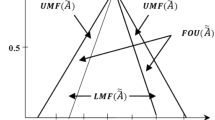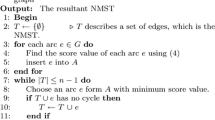Abstract
Fuzzy minimum spanning tree (FMST) has emerged from various real-life applications in different areas by considering uncertainty that exists in arc lengths of a fuzzy graph. In most relevant studies regarding FMST, type 1 fuzzy set was used to represent edge weights. Nonetheless, its membership values are totally crisp which is hard to determine its exact value by human perception. Interval type 2 fuzzy set (IT2FS) increases the number of degrees of freedom to express uncertainty of the edge weight and has more capacity to describe fuzzy information in a logically correct manner. In this paper, we propose the minimum spanning tree problem with undirected connected weighted interval type 2 fuzzy graph (FMST-IT2FS). Herein, the interval type 2 fuzzy set is used to represent the arc lengths of a fuzzy graph. Then, a new genetic algorithm is proposed to solve the FMST-IT2FS problem with the addition, ranking and defuzzification of IT2FSs being used. Illustrative examples are included to demonstrate the effectiveness of the proposed algorithm.











Similar content being viewed by others
References
Ali M, Son LH, Deli I, Tien ND (2017) Bipolar neutrosophic soft sets and applications in decision making. J Intell Fuzzy Syst 33:4077–4087
Ali M, Son LH, Khan M, Tung NT (2018) Segmentation of dental x-ray images in medical imaging using neutrosophic orthogonal matrices. Expert Syst Appl 91:434–441
Ali M, Dat LQ, Son LH, Smarandache F (2018) Interval complex neutrosophic set: formulation and applications in decision-making. Int J Fuzzy Syst 20(3):986–999
Ali M, Son LH, Thanh ND, Van Minh N (2018) A neutrosophic recommender system for medical diagnosis based on algebraic neutrosophic measures. Appl Soft Comput 71:1054–1071
Almeida DTA, Yamakami A, Takahashi MT (2005) An evolutionary approach to solve minimum spanning tree problem with fuzzy parameters. In: CIMCA/IAWTIC. pp. 203–208
Bondy JA, Murty USR (1976) Graph theory with applications, vol 290. Macmillan, London
Chang PT, Lee E (1999) Fuzzy decision networks and deconvolution. Comput Math Appl 37(11):53–63
Chen TY (2013) A linear assignment method for multiple-criteria decision analysis with interval type-2 fuzzy sets. Appl Soft Comput 13(5):2735–2748
Chen SM, Yang MW, Yang SW, Sheu TW, Liau CJ (2012) Multicriteria fuzzy decision making based on interval-valued intuitionistic fuzzy sets. Expert Syst Appl 39(15):12085–12091
Dat LQ, Thong NT, Son LH, Ali M, Smarandache F, Abdel-Basset M, Long HV (2019) Linguistic approaches to interval complex neutrosophic sets in decision making. IEEE Access. https://doi.org/10.1109/ACCESS.2019.2902841
Dereli T, Altun K (2013) Technology evaluation through the use of interval type-2 fuzzy sets and systems. Comput Ind Eng 65(4):624–633
Dijkstra EW (1959) A note on two problems in connexion with graphs. Numer Math 1(1):269–271
Gao J, Lu M (2005) Fuzzy quadratic minimum spanning tree problem. Appl Math Comput 164(3):773–788
Graham RL, Hell P (1985) On the history of the minimum spanning tree problem. Ann History Comput 7(1):43–57
Harel D, Tarjan RE (1984) Fast algorithms for finding nearest common ancestors. SIAM J Comput 13(2):338–355
Itoh T, Ishii H (1996) An approach based on necessity measure to the fuzzy spanning tree problems. J Oper Res Soc Japan 39(2):247–257
Janiak A, Kasperski A (2008) The minimum spanning tree problem with fuzzy costs. Fuzzy Optim Decis Mak 7(2):105–118
Jha S, Son LH, Kumar R, Priyadarshini I, Smarandache F, Long HV (2019) Neutrosophic image segmentation with dice coefficients. Measurement 134:762–772
Jha S, Kumar R, Chiclana F, Puri V, Priyadarshini I (2019) Neutrosophic approach for enhancing quality of signals. Multimed Tools Appl. https://doi.org/10.1007/s11042-019-7375-0
Karnik NN, Mendel JM (2001) Centroid of a type-2 fuzzy set. Inf Sci 132(1):195–220
Khan M, Son LH, Ali M, Chau HTM, Na NTN, Smarandache F (2018) Systematic review of decision making algorithms in extended neutrosophic sets. Symmetry 10:314–342
Kruskal JB (1956) On the shortest spanning subtree of a graph and the traveling salesman problem. Proc Am Math Soc 7(1):48–50
Lee LW, Chen SM (2008) A new method for fuzzy multiple attributes group decision-making based on the arithmetic operations of interval type-2 fuzzy sets. In: 2008 International conference on machine learning and cybernetics, vol. 6, pp. 3084–3089. IEEE
Liu B (2004) Uncertainty theory: an introduction to its axiomatic foundations. Springer, Berlin
Liu B, Liu B (2002) Theory and practice of uncertain programming. Springer, Berlin
Mendel JM (2016) A comparison of three approaches for estimating (synthesizing) an interval type-2 fuzzy set model of a linguistic term for computing with words. Granul Comput 1(1):59–69
Mendel JM, John RIB (2002) Type-2 fuzzy sets made simple. IEEE Trans Fuzzy Syst 10(2):117–127
Mendel JM, John RI, Liu F (2006) Interval type-2 fuzzy logic systems made simple. IEEE Trans Fuzzy Syst 14(6):808–821
Morales OS, Devia JHS, Mendez JJS (2011) Centroid of an interval type-2 fuzzy set: continuous vs. discrete. Ingeniera 16(2):67–78
Nguyen GN, Son LH, Ashour AS, Dey N (2019) A survey of the state-of-the-arts on neutrosophic sets in biomedical diagnoses. Int J Mach Learn Cybern 10(1):1–13
Prim RC (1957) Shortest connection networks and some generalizations. Bell Syst Tech J 36(6):1389–1401
Son LH (2017) Measuring analogousness in picture fuzzy sets: from picture distance measures to picture association measures. Fuzzy Optim Decis Mak 16(3):359–378
Son NTK, Dong NP, Son LH, Long HV (2019) Towards granular calculus of single-valued neutrosophic functions under granular computing. Multimed Tools Appl. https://doi.org/10.1007/s11042-019-7388-8
Thanh ND, Ali M, Son LH (2017) A novel clustering algorithm in a neutrosophic recommender system for medical diagnosis. Cognit Comput 9(4):526–544
Thong NT, Dat LQ, Son LH, Hoa ND, Ali M, Smarandache F (2019) Dynamic interval valued neutrosophic set: modeling decision making in dynamic environments. Comput Ind 108:45–52
Wang W, Liu X, Qin Y (2012) Multi-attribute group decision making models under interval type-2 fuzzy environment. Knowl Based Syst 30:121–128
Wu D, Mendel JM (2007) Uncertainty measures for interval type-2 fuzzy sets. Inf Sci 177(23):5378–5393
Wu D, Mendel JM (2009) A comparative study of ranking methods, similarity measures and uncertainty measures for interval type-2 fuzzy sets. Inf Sci 179(8):1169–1192
Zadeh LA (1975) The concept of a linguistic variable and its application to approximate reasoning. Inf Sci 8(3):199–249
Zhou J, Chen L, Wang K, Yang F (2016) Fuzzy \(\alpha -\)minimum spanning tree problem: definition and solutions. Int J Gen Syst 45(3):311–335
Author information
Authors and Affiliations
Corresponding author
Ethics declarations
Conflict of interest
The authors declare that they have no conflict of interest.
Additional information
Communicated by V. Loia.
Publisher's Note
Springer Nature remains neutral with regard to jurisdictional claims in published maps and institutional affiliations.
Rights and permissions
About this article
Cite this article
Dey, A., Son, L.H., Pal, A. et al. Fuzzy minimum spanning tree with interval type 2 fuzzy arc length: formulation and a new genetic algorithm. Soft Comput 24, 3963–3974 (2020). https://doi.org/10.1007/s00500-019-04166-1
Published:
Issue Date:
DOI: https://doi.org/10.1007/s00500-019-04166-1




